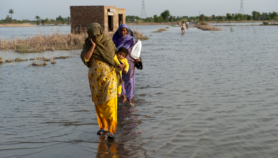By: Archita Bhatta
Send to a friend
The details you provide on this page will not be used to send unsolicited email, and will not be sold to a 3rd party. See privacy policy.
[NEW DELHI] Even as the India Meteorological Department (IMD) forecasts a deficient monsoon for 2015, studies says that low intensity monsoons accompanied by extreme rainfall events are becoming a trend.
The south western monsoon from June to September accounts for 80 per cent of rainfall over the Indian sub-continent with agriculture heavily dependent on its timeliness and regularity. IMD’s forecast for this season is a low 92 per cent of average, while extreme rainfall early June has resulted in floods in western India.
Scientists at the Indian Institute of Science (IISc), Bangalore, have found decreased intensity of moderate rains and extreme rainfall events during the monsoon. The study, published in Environmental Research Letters in May, says that the decrease in rainfall mid-monsoon is balanced by a rise in extreme events in the early and late monsoon months.
“What we have witnessed is a redistribution of rainfall intensity among periodic (low-frequency) and non-periodic (extreme) modes in a changing climate scenario, but the total rainfall over India has remained constant over 100 years,” says Arindam Chakraborty, atmospheric scientist at the IISc and an author of the study.
“While earlier scientists have pointed out trends in decrease of moderate rainfall events and increase in extreme rainfall events, we have identified the time of the year when these changes are occurring. This will make it easier to find out the cause behind it,” he added.
The team which analysed rainfall data from 1951—2013 now proposes to examine whether existing weather prediction models can simulate these changes and if required make necessary modifications in the models for improving prediction.
Another paper, published in Nature Communication on 16 June, indicates a similar trend of weakening monsoon by analysing rainfall data between 1901 and 2012. The study team from the Indian Institute of Tropical Meteorology (IITM), Pune, identified rapid Indian Ocean warming and resultant weakening of land-sea temperature differences as the reason behind the diminishing South Asian monsoon.
“We found that rainfall is decreasing over central South Asia — from south Pakistan through central India to Bangladesh. The decrease is highly significant over central India where agriculture is still mostly rain-fed, with a reduction of up to 10—20 per cent in the mean rainfall, says Mathew Koll Roxy, scientist at IITM and lead author of the study.
The study found that the land-sea thermal contrast over the South Asia has reduced in the past decades, primarily due to a strong warming in the Indian Ocean combined with suppressed warming over the Indian land mass.
“This trend is likely to continue for some more years. It is interesting to know that in spite of decrease in seasonal rainfall, extreme rainfall events are increasing, However, we do not have adequate knowledge why these are observed,” said Rajeevan Madhavan Nair, director of the IITM.
>Link to full paper in Environmental Research Letters
This article has been produced by SciDev.Net's South Asia desk.














